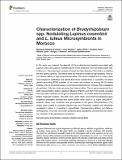Por favor, use este identificador para citar o enlazar a este item:
http://hdl.handle.net/10261/269118COMPARTIR / EXPORTAR:
 SHARE SHARE
 CORE
BASE CORE
BASE
|
|
| Visualizar otros formatos: MARC | Dublin Core | RDF | ORE | MODS | METS | DIDL | DATACITE | |

| Título: | Characterization of Bradyrhizobium spp. nodulating Lupinus cosentinii and L. luteus microsymbionts in Morocco |
Autor: | Missbah El Idrissi, M.; Bouhnik, O.; ElFaik, S.; Alami, S.; Lamin, H.; Bedmar, Eulogio J. CSIC ORCID; Abdelmoumen, H. | Palabras clave: | Lupinus Bradyrhizobium Symbiosis Nodulation Diversity MLSA |
Fecha de publicación: | 2021 | Editor: | Frontiers Media | Citación: | Frontiers in Agronomy 3: 661295 (2021) | Resumen: | In this work, we analyzed the diversity of the nodule-forming bacteria associated with Lupinus luteus and Lupinus cosentinii grown in the Maamora Cork oak forest acidic soils in Morocco. The phenotypic analysis showed the high diversity of the strains nodulating the two lupine's species. The strains were not tolerant to acidity or high alkalinity. They do not tolerate salinity or high temperatures either. The strains isolated from L. luteus were more tolerant to antibiotics and salinity than those isolated from L. cosentinii. The plant growth promoting (PGP) activities of our strains are modest, as among the 28 tested isolates, only six produced auxins, six produced siderophores, whereas three solubilized phosphates. Only two strains possess the three activities. The rrs gene sequences from eight representative strains selected following ARDRA and REP-PCR results revealed that they were members of the genus Bradyrhizobium. Six strains were then retained for further molecular analysis. The glnII, recA, gyrB, dnaK, and rpoB housekeeping gene sequence phylogeny showed that some strains were close to B. lupini LMG28514 whereas others may constitute new genospecies in the genus Bradyrhizobium. The strains were unable to nodulate Glycine max and Phaseolus vulgaris and effectively nodulated L. luteus, L. cosentinii, L. angustifolius, Chamaecytisus albidus, and Retama monosperma. The nodC and nodA symbiotic gene phylogenies showed that the strains are members of the genistearum symbiovar. | Versión del editor: | http://doi.org/10.3389/fagro.2021.661295 | URI: | http://hdl.handle.net/10261/269118 | DOI: | 10.3389/fagro.2021.661295 | Identificadores: | doi: 10.3389/fagro.2021.661295 issn: 2673-3218 |
| Aparece en las colecciones: | (EEZ) Artículos |
Ficheros en este ítem:
| Fichero | Descripción | Tamaño | Formato | |
|---|---|---|---|---|
| 2021_Missbah_FA_OA.pdf | 4,03 MB | Adobe PDF |  Visualizar/Abrir |
CORE Recommender
SCOPUSTM
Citations
5
checked on 03-abr-2024
WEB OF SCIENCETM
Citations
5
checked on 21-feb-2024
Page view(s)
36
checked on 18-abr-2024
Download(s)
117
checked on 18-abr-2024
Google ScholarTM
Check
Altmetric
Altmetric
Este item está licenciado bajo una Licencia Creative Commons

